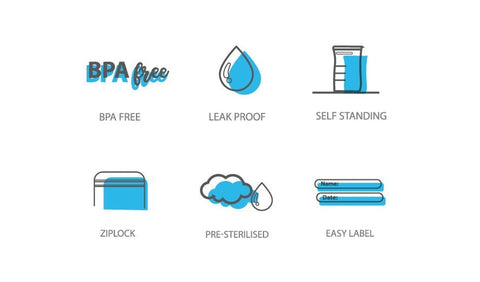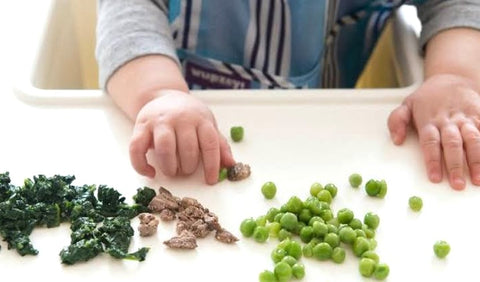How To Use Baby Food Pouches

On this Page:
- Why Use Baby Food Pouches?
- Advantages Of Using Reusable Pouches
- When To Use Baby Food Pouches And When To Stop
- Incorporate A Spoon
- Mix In More Texture
- Start Finger Foods Between Six and Eight Months
- Always Sit To Eat
- Downsides Of Feeding Your Baby With Commercial Purees
Baby food pouches are the new trend for feeding your baby and for baby food storage. They’re convenient, nutritious, easy to use and the reusable food pouches are even easy to clean. They also help promote self-feeding, all good stuff. But do you know when and how to use baby food pouches? Read on to find out more.
Like anything in life, good things should be used in small doses, and it’s the same with baby food pouches. In this article we will explain the proper use of baby food pouches for feeding your little one and for baby food storage.
Why Use Baby Food Pouches?
The number one reason to use baby food pouches is that they’re so convenient. Pouches offer portable, nutritious meals that fit in with our crazy busy lives. While the store bought pouches are not an adequate substitute for fresh fruit and veggies, purees in pouches still have a decent amount of nutrition and can provide much-needed vitamins and minerals, especially important for children with feeding difficulties.

Advantages Of Using Reusable Pouches
Reusable baby food pouches are great for homemade baby food storage, while still having the advantages for independent feeding. Making your own baby food is cheaper than store bought pouches, plus you have full control of what you are feeding your baby. Simply steam and mash veggies or puree fruits, fill the pouches and freeze. Baby food storage couldn’t be easier! The added advantage of making your own baby food is that you can also control the texture – smooth for young babies and then gradually increasing the texture as they get older.

YOU MAY ALSO BE INTERESTED IN:
The Ultimate Guide to Baby Fresh Food Feeders
When To Use Baby Food Pouches And When To Stop
The convenience of baby food pouches cannot be denied, but they should not be relied on as the main source of food for your baby. The following is a general guide as to when to use them and when to stop:
- Food pouches are great for emergency’s or for busy mum’s on the go. You can keep them stashed in a cupboard or in your nappy bag, ready to use when your baby shows signs of being hungry.
- They’re an instant fix for a hungry child who can’t wait to eat.
- They minimise messy eating. The clean up after meals is so simple and there is no washing up.
- Use them alongside finger foods to add texture to your baby’s diet.
- Instead of just letting your baby suck on the puree pouches, empty the puree into a bowl and feed with a spoon.
- They should not be used for babies under 4-6 months old when they should be exclusively fed breast milk or formula.
- Set developmental goals for you child. All babies need diversified texture so they learn to chew, self-feed and advance their feeding skills.
- Babies who do not advance to more textured food by 9 months of age have been shown to have a greater likelihood of having feeding problems later.
For a more in-depth look at introducing solids you can read all about it here.

Incorporate A Spoon
The original idea for baby food pouches was to use them with a spoon. Parents could squeeze a bit of baby food onto the spoon and feed it to their baby. Today, the spoon is mostly skipped and sucking from the pouch has become the norm. This misses the opportunity to teach baby how to eat off a spoon and use their mouth muscles to manage, propel and chew food.
Here at Cherub Baby, we have created the perfect match for our reusable food pouches. Simply screw one of our food pouch spoons onto our food pouches or any major brand food pouch from the supermarket, and feed baby instantly. Using our food pouch spoon helps with the development of your baby’s mouth muscles.

Mix In More Texture
What if you just don’t have the time to make homemade baby food? Can you still use the shop bought pouches? By adding textured foods such as chopped and cooked veggies, rice, noodles or shredded meats in a bowl with the baby food from pouches will increase the texture. These varied textures will stimulate your baby’s sensory system and train his mouth muscles to handle a wider range of food textures.
Be careful not to add too many different foods at the same time. While introducing new foods, start with one teaspoon at a time and slowly increase the quantity and frequency. Also leaving 3-4 days between introducing new foods can be a good way to identify allergies or intolerances.

Start Finger Foods Between Six and Eight Months
Between six and eight months, babies develop their hand grip and can hold a finger-shaped rectangle of soft food. At this stage you can introduce foods likes buttered toast, soft cooked vegetables like sweet potato, or ripe fruit like banana or avocado. By eight months, the pincer grasp emerges, and your baby should be able to pick up small bits of food with his thumb and forefinger.
At this stage, introduce finer foods like strips and small cubes of soft food to your baby’s meal routine. Use this opportunity to introduce singular veggies and fruits so your baby can appreciate the flavor and texture of these foods.

Always Sit To Eat
This is good advice for anybody of any age (even adults), but especially for the new eater who is learning to handle food. Don’t let young children and toddlers walk around when eating as this increases the risk of choking. Sitting for meals and snacks helps children pay attention to their food, to learn to eat mindfully and to stop eating when they are full. Eating as a family also encourages ‘family bonding’ time where people can take time to find out about each other’s day.

Downsides Of Feeding Your Baby With Commercial Purees
Commercial, store bought pouches are extremely convenient, but home made is always best, here’s why:
- Labels may be misleading. Companies proudly tout they they are organic, natural and there’s no artificial ingredients, which all give a ‘feel good’ factor. But while the front label will proudly proclaim healthy ingredients and superfoods (like kale, quinoa or blueberries) if you check the ingredients listed, the cheaper fruit and veggies (like carrot, potato or pear puree) will be the main ingredients
- Shop bought purees are very smooth, almost liquid. This does not give your baby the varied textures needed for development. The food pouches encourage sucking which your baby will already be pretty competent with.
- Commercial purees mostly come in combinations such as vegetable/fruit combos so individual foods can’t be tasted on their own.
- Purees from pouches do not help to expand your baby’s palate. Most of them taste sweet, even those with kale, spinach, whole grains, and other generally not-sweet tasting ingredients. Kids already love sweet stuff. Our goal as parents is to help babies develop a taste for the foods they do not like yet, such as vegetables, grains, and meats.
IMPORTANT
It’s fair to say that commercial purees do have their place, as long as you don’t become over reliant on them. Reusable food pouches, which encourage you to make and store homemade baby food, are the way to go!



